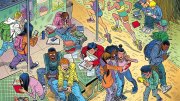Like it or not, children and teenagers today are live participants in an unprecedented experiment, as the sudden ubiquity of smartphones and hyper-engaging social media influences their development. Parents and educators who are not as digitally savvy wonder how to help youths navigate this landscape, amid evidence that the prevalence of anxiety and depression has increased sharply among teenagers during the last 15 years, the period that overlaps with the arrival of these technologies.
Researchers from the Harvard Graduate School of Education’s Center for Digital Thriving are exploring some of the unknowns, aiming to detail the pressures teens face and to understand the role screen-based technology might play. They find that while teens point to ways that screen time can amplify distress, it may also in some cases help young people cope.
The researchers surveyed 1,545 U.S. teens in the fall of 2023, asking about six areas in their lives that are potential sources of negative pressure, such as academics and social relationships. Focus groups of other teens (who had not completed the survey) later helped interpret the results.
The findings reveal that young people are indeed feeling squeezed; 81 percent of respondents struggled in one of six domains while more than half felt negative pressure in three or more. This provided a detailed picture of how teens experience so-called “grind culture,” which they described as “this sense of always needing to be productive, to be striving in all these different areas, even at the expense of your health,” says Emily Weinstein, co-director of the center.
Among the teenagers surveyed, 56 percent felt “game plan” pressure, or “the feeling that they have to have their future path clear and set,” Weinstein explains. Some 53 percent experienced achievement pressure, or the push to earn impressive grades or excel at sports. Other pressures included the need to look their best (felt by 51 percent of those surveyed); pressure to be seen as having a robust social life (a concern for 44 percent); friendship pressure, or the need to be available to support friends (41 percent); and activism, or the push to stay informed and do good for their community (32 percent). All six of these pressures were more severe for girls and teens who identified as nonbinary or lesbian, gay, bisexual, transgender, queer, or another sexual or gender minority.
Weinstein notes that this and other center projects are guided by teen advisers who offer sometimes surprising insights. In this case, the young people helped distinguish “game plan” pressure from the more familiar push to achieve. “This finding is interesting to me as an adolescent psychologist because we tend to think of the adolescent years as an important time for exploration, for figuring out who you are and who you want to be,” she says. “But we have teens telling us there is no time for that.” In effect, in the always-online era, young people feel that they must identify a path and push forward, concerned that noodling around with new interests or ideas will put them behind.
Also distressing, one in four of the teenagers surveyed reported struggling with burnout, a state more common among adults in high-pressure jobs. One focus group participant, Weinstein says, shared a comment from her older brother, who said, “I feel like a train who’s burned off every ounce of fuel that’s left, but still hasn’t reached the station.”
When the researchers asked teens where the pressure usually originated, they pointed to the adults in their lives, including their parents and teachers, even as they also put pressure on themselves. Among the participants who experienced appearance pressure, roughly three-quarters said that social media sometimes made it worse—and they reported that using Instagram, TikTok, and Snapchat intensified that pressure.
Social gaming, or online games that kids play with others, on the other hand, were described as a kind of release valve, distracting teens from the pressures they faced. And even though social media apps often amplify pressure, for some teens they can also reduce it. Previous studies found that “social media can be a real source of inspiration,” Weinstein explains. “It can provide meaningful validation, the sense of being seen or not being alone.”
Interestingly, 19 percent of the teens surveyed did not experience pressure in any of the domains identified in the study. Looking specifically at those teens, “several practices and patterns emerge,” write the authors. They tend to get more sleep, are more likely to spend time outdoors, and tend to have more open schedules. In their unscheduled time, they are less likely than other students to watch a lot of television, less likely to say they use the internet “almost constantly,” and are only half as likely to be in the top 25 percent of social media users. In general, the researchers found that more self-care is also associated with a lower likelihood of feeling burned out. “On average, for each additional self-care practice that teens reported at least weekly,” the researchers found, there was “a 23 percent decrease in their likelihood of being burned out.”
Sara Konrath of Indiana University, who collaborated with Weinstein and her team, identified some of the self-care practices, supported by previous research, that can restore well-being and ward off burnout. These include getting seven or more hours of sleep a night, exercising an hour or more each day, spending time in nature, hanging out with a friend, and engaging in creative projects. But most teenagers, Weinstein says, are not getting enough of these activities. Some explained that they struggle to find time for things not tied to achievement, she notes: “Teens literally described feeling guilty for reading a book for pleasure.”
Weinstein observes that young people often reach for their screens because they are an easy way to take their minds off schoolwork or stress. “Screen time isn’t always wasted time, but it can definitely displace other activities and then leave teens—and adults—regretful that they’ve wasted time they wish they’d spent differently,” she says. While the study didn’t ask how much screen time teens spend on apps, about one-fifth of them said they use TikTok, messaging apps, YouTube, and Snapchat “almost constantly.” (Data from the Centers for Disease Control show that youths 12 to 17 years old accumulate four hours or more of daily screen time independent of schoolwork.) Weinstein encourages adults to ask teens what other activities they want to prioritize, and help facilitate that if possible. That way, “Unhelpful screen time will be displaced naturally.” Adults can also emphasize the value of cultivating interests and hobbies without worrying if they will enhance college applications.
“The data are really urging us to be able to hold multiple truths about teens and tech,” Weinstein continues, “and to be clearheaded about the ways that social media can become toxic.” At the same time, she stresses, “if we really want to be able to have a textured and timely view” of the challenges facing this first generation to be raised in a digital culture, it’s also important to engage with teens about “the things that are hard in their lives, and to be open to hearing their views on the positives of tech.”









